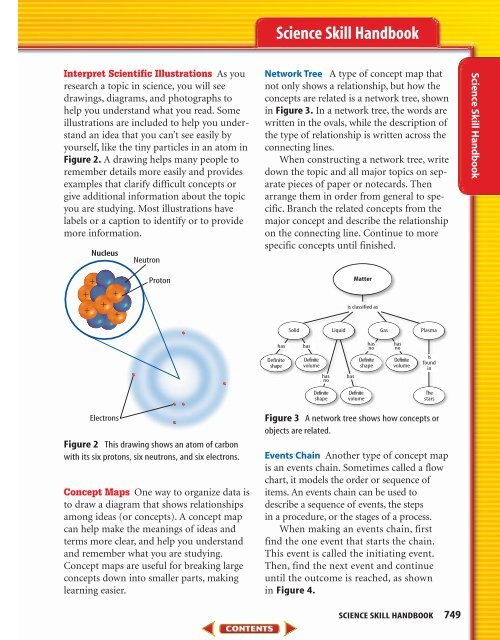Student Resources—746
Student Resources—746
Student Resources—746
Create successful ePaper yourself
Turn your PDF publications into a flip-book with our unique Google optimized e-Paper software.
Interpret Scientific Illustrations As you<br />
research a topic in science, you will see<br />
drawings, diagrams, and photographs to<br />
help you understand what you read. Some<br />
illustrations are included to help you understand<br />
an idea that you can’t see easily by<br />
yourself, like the tiny particles in an atom in<br />
Figure 2. A drawing helps many people to<br />
remember details more easily and provides<br />
examples that clarify difficult concepts or<br />
give additional information about the topic<br />
you are studying. Most illustrations have<br />
labels or a caption to identify or to provide<br />
more information.<br />
<br />
Nucleus<br />
<br />
<br />
<br />
<br />
Electrons<br />
Neutron<br />
Proton<br />
Figure 2 This drawing shows an atom of carbon<br />
with its six protons, six neutrons, and six electrons.<br />
Concept Maps One way to organize data is<br />
to draw a diagram that shows relationships<br />
among ideas (or concepts). A concept map<br />
can help make the meanings of ideas and<br />
terms more clear, and help you understand<br />
and remember what you are studying.<br />
Concept maps are useful for breaking large<br />
concepts down into smaller parts, making<br />
learning easier.<br />
Science Skill Handbook<br />
Network Tree A type of concept map that<br />
not only shows a relationship, but how the<br />
concepts are related is a network tree, shown<br />
in Figure 3. In a network tree, the words are<br />
written in the ovals, while the description of<br />
the type of relationship is written across the<br />
connecting lines.<br />
When constructing a network tree, write<br />
down the topic and all major topics on separate<br />
pieces of paper or notecards. Then<br />
arrange them in order from general to specific.<br />
Branch the related concepts from the<br />
major concept and describe the relationship<br />
on the connecting line. Continue to more<br />
specific concepts until finished.<br />
Definite<br />
shape<br />
Matter<br />
is classified as<br />
Solid Liquid Gas Plasma<br />
has has has<br />
no<br />
Definite<br />
volume<br />
has<br />
no<br />
Definite<br />
shape<br />
has<br />
Definite<br />
volume<br />
Definite<br />
shape<br />
Figure 3 A network tree shows how concepts or<br />
objects are related.<br />
Events Chain Another type of concept map<br />
is an events chain. Sometimes called a flow<br />
chart, it models the order or sequence of<br />
items. An events chain can be used to<br />
describe a sequence of events, the steps<br />
in a procedure, or the stages of a process.<br />
When making an events chain, first<br />
find the one event that starts the chain.<br />
This event is called the initiating event.<br />
Then, find the next event and continue<br />
until the outcome is reached, as shown<br />
in Figure 4.<br />
has<br />
no<br />
Definite<br />
volume<br />
is<br />
found<br />
in<br />
The<br />
stars<br />
SCIENCE SKILL HANDBOOK 749<br />
Science Skill Handbook
















